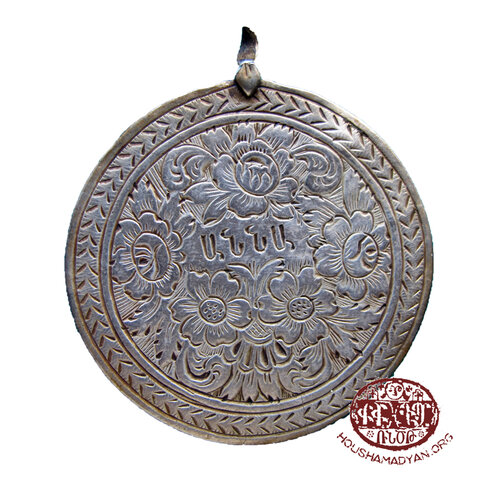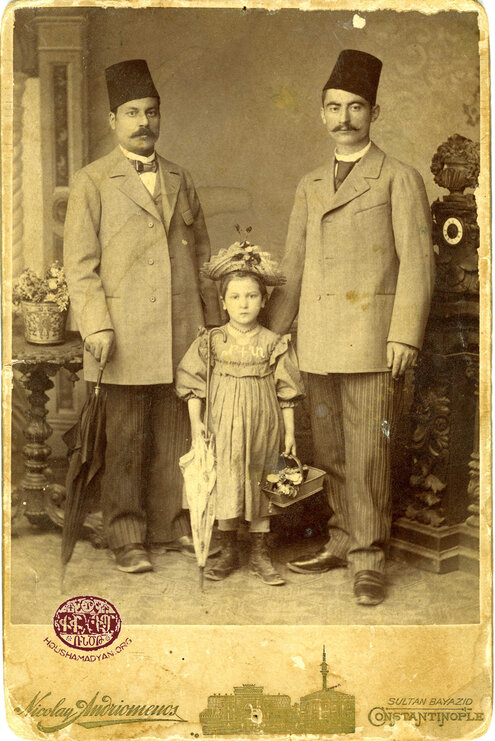Bossière/Mantarian collection - Nantes, France
The items and the pictures in this collection belong to families originally from Harput/Kharpert. They are currently a part of the Gérard and Véra (née Mantarian) Bossière family collection in Nantes (France). Part of Véra’s ancestry comes from the Assyrian community of Harput who spoke Armenian and as we see from the examples on this page, they would often marry Armenians from Harput. Branches of the Mantarian family are now spread worldwide, mainly France and the United States.
Silver medallion with the name “Anna” engraved on it, which likely belonged to the first owner of the medallion, Anna Barsoum Malcom. Anna was born in Harput/Kharpert in 1837. She was a member of the Harput Assyrian community. At the end of the 19th century, Anna immigrates to the United States with her family. Her daughter Nazli, who was married to an Assyrian (Aharon Arslan), remains in Harput. This medallion was probably given to Nazli as something to remember her mother by. Later, Nazli’s daughter Maritsa inherits the medallion, which is currently in the possession of Maritsa’s granddaughter Véra (Mantarian) Bossière, in Nantes.
Harput, Malke family. The identity of only two people in this photograph is known. Seated, front first right is Malke, who was later going to become one of the victims of the 1915 Genocide. He is still single in this picture. He would later go on to marry Maritsa Malcom. The girl standing first from the right is Elise (Malke’s sister, who was born in Harput and died in Istanbul, around 1950s). The couple sitting to Malke’s left are most likely his parents.
Hussenig (Harput/Kharpert plain). The Mantarian family, ca. 1912. Seated (from left): Hovagim (1870-1915); Hovagim’s son (name unknown, killed in 1915); Garabed Mantarian (born 1840), father of Hovagim and Kevork; and Kevork (1885-1915). Children in front row (from left): Mariam (born 1911, Hussenig) and Garbis/Garabed (born 1910, Hussenig), the son of Kevork and Hayganoush. Standing (from left): [unknown]; Hovagim’s wife (name unknown); [unknown]; [unknown]; [unknown]; Hayganoush Mantarian (née Boyadjian, born ca. 1890, Hussenig).
Garbis/Garabed is a member of this family who survived the Genocide. Later, he manages to reach France and marries Janet, Maritsa Malke’s (Arslan) daughter. The photograph is currently a part of Véra (Mantarian) Bossière’s family collection; Garbis’s and Janet’s daughter.
1) Left to right: Aharon Arslan (born and deceased in Harput), center: his daughter Maritsa (1893 Istanbul or Harput-1926 Istanbul), person on the right: unknown. The Armenian letters M and D are embroidered on Maritsa’s dress.
2) The Arslan family: Left: Nazli Arslan (born Barsoum, 1863 Harput- 1952/1955 Harput), next to Nazli is Aharon Arslan, her husband, in his arms: Naoum (1896 Istanbul-1955 Harput), the little girl: Maritsa (1893-1962).
1) Hairpin decoration in the shape of a bird which belonged to Maritsa Malcom.
2) Anna Malcom (1837-1937), born in Harput to an Assyrian family. At the end of the 19th century, Anna immigrates to the United States with her family. Her daughter Nazli, who was married to an Assyrian (Aharon Arslan) remains in Harput. Anna dies in Fresno, she was 100 years old.











